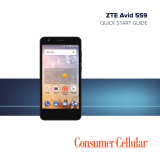
11
noise and phones also vary in the amount of interference they
generate. The wireless telephone industry has developed a
rating system for wireless phones to assist hearing device
users in finding phones that may be compatible with their
hearing devices. Not all phones have been rated. Phones that
are rated have the rating on their box or a label located on the
box. These ratings are not guaranteed. Results will vary,
depending on the level of immunity of your hearing device and
the degree of your hearing loss. If your hearing device
happens to be vulnerable to interference, you may not be able
to use a rated phone successfully. Trying out the phone with
your hearing device is the best way to evaluate it for your
personal needs.
This phone has been tested and rated for use with hearing
aids for some of the wireless technologies that it uses.
However, there may be some newer wireless technologies
used in this phone that have not been tested yet for use with
hearing aids. It is important to try the different features of this
phone thoroughly and in different locations, using your hearing
aid or cochlear implant, to determine if you hear any
interfering noise. Consult your service provider or the
manufacturer of this phone for information on hearing aid
compatibility. If you have questions about return or exchange
policies, consult your service provider or phone retailer.
M-Ratings: Phones rated M3 or M4 meet FCC requirements
and are likely to generate less interference to hearing devices
than phones that are not labeled. M4 is the better/higher of the
two ratings.
T-Ratings: Phones rated T3 or T4 meet FCC requirements
and are likely to be more usable with a hearing device’s
telecoil (“T Switch” or “Telephone Switch”) than unrated
phones. T4 is the better/ higher of the two ratings. (Note that
not all hearing devices contain telecoils.)
Your Z3153V has been tested for hearing aid device
compatibility and has an M4/T3 rating.
Hearing devices may also be measured for immunity to this






















